#javanese
Explore tagged Tumblr posts
Text
i haven't posted anything here omg kinda nervous... but here's zutara in traditional javanese wedding attire 🙇🏻♀️ commissioned this from my friend she's amazing 😖❗️
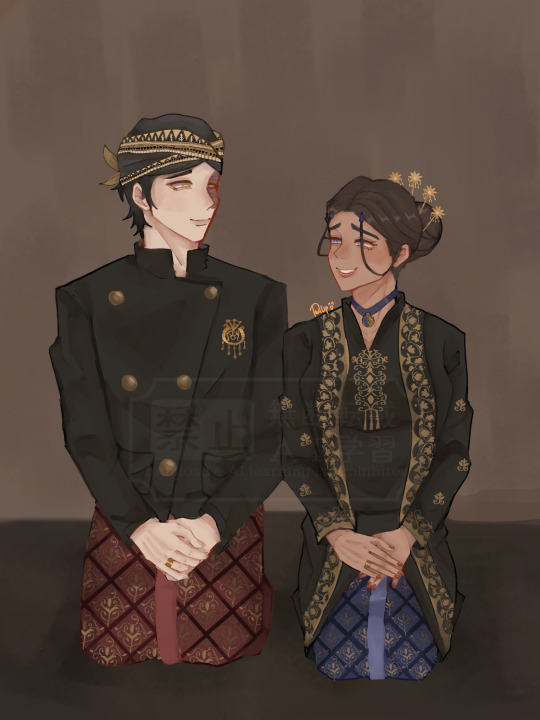
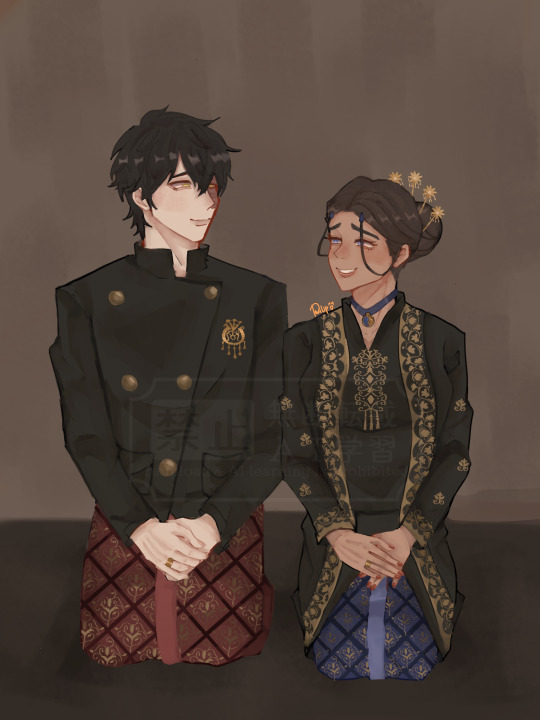
some facts about the attire! ☺️😙
The headwear these babies are wearing are called Blangkon and Cunduk Mentul, Blangkon is a traditional headwear worn by men usually in Central Javanese and Yogyakarta (especially the one Zuko is wearing!) The word Blangkon itself is said to came from the word 'blanco' referring to the blank cloth used to make the headwear, tho there are soo many theories about the origin of both the headwear and the name itself cause sadly there aren't many records about it :(
The headwear is also used to represent wisdom and class because back then, these were used to differentiate the nobilities from the commoners (wr don't really do that anymore dw). The Javanese people believe that your hair, head, and face are the most important and treasured parts of your body, so these Blangkon are used to protect those parts. We also believe that Blangkon represent self-control, since Javanese men tend to keep their hair long back then and keep them loose when they're in a state of 'conflict' such as battles or war, representing uncontrollable flow of emotions so keeping their hair up and covered is seen as an act of self control.
As for the Cunduk Mentul, these pretty headpieces are typically worn by brides on their wedding day! They represent 'the sun that shines over the universe' and also... well, it depends on the number of the pieces they use, usually it's 1, 3, 5, 7, or 9, each representing a different value. 1 is used as a symbol of God's singularity, usually worn by muslim brides, 3 is for the Trimurti or the Trinity of Hindu Gods that deeply rooted in Javanese values, 5 is for the five pillars of Islam, 7 symbolizes 'help' or 'aid'- the Javanese believe that 7 is a lucky number since 7 is 'pitu' in Javanese, so, yeah, 'pitu' for 'pitulungan' or help and aid in Javanese language. 9 represent the Nine Saints/Wali Sanga, 9 saints that have a major impact on the growth of Islam in the island of Java.
Their clothing respectively are called Beskap and Kebaya 🤩 Beskap is more of a modern version of Javenese traditional clothing, for it was adopted from the modern suits worn by the Deutsch during the colonization era. The word Beskap came from the word 'beschaafd', meaning civilized (oh!)
Kebaya, on the other hand, has no specific area origin cause each region has their own styles and versions! The one Katara is wearing is a Central Java Kebaya tho, famous for the velvety fabric and dark colors along with the gold motifs. The history of 'modern' Kebaya itself started in the 15th century when Dutch first settled in Dutch East Indies (now Indonesia!) The clothing had taken inspirations from different cultures (like Chinese and Indian) along the way since Indonesia was (kinda still is!) One of the centers of trade routes for both Hindia and Pacific Oceans.
Damn I'm getting tired of writing this, but next 😭 is Kain Jarik! A piece of fabric with Batik motives wrapped around the legs :))) these babies have RANGE, like they could be used daily, for traditional dance attire, sacred rituals, weddings, even used in funerals 😀 they're usually 2 to 3 meters in length and more variations in width, easy to customize! They also usually have dark colors like dark brown and light brown motives, but i asked my friend to draw them with red and blue and gold motives cause why not 😝
Anyways I think i went a little overboard cause my fingers are hurting from typing this lol.
#zutara#zutarian#zuko x katara#katara#zuko#atla fanart#atla#zutara fanart#fanart#atla zutara#traditional clothing#javanese#idk how to tag this#is this okay?#anyway#commission#art commisions
302 notes
·
View notes
Text

A group of Javanese women dancing in Sumatra, Indonesia (1870)
#southeast asia#asia#sumatra#indonesia#java#javanese#moros#moors#moorish#dancers#dancing#1800's#photography#💃🏾#🇮🇩
99 notes
·
View notes
Text

Javanese women from Yogyakarta, Java, Indonesia
Dutch vintage postcard
#historic#javanese#photography#postal#ansichtskarte#indonesia#yogyakarta#photo#sepia#vintage#postcard#java#women#briefkaart#postkarte#tarjeta#carte postale#ephemera#postkaart#dutch
89 notes
·
View notes
Text

Armin and Annie are dressed in traditional Javanese wedding attire
Eremika vers. .
Ko-fi . Bluesky .
#kuas mima#armin arlert#annie leonhart#attack on titan#Black and gold suits them very well#Those payet are so tiring to draw yet so worth it#aot fanart#aot#shingeki no kyojin#armin aot#annie aot#armin x annie#art#artists on tumblr#digital art#drawing#illustration#fanart#javanese
28 notes
·
View notes
Text
Olivia halford wearing kebaya (traditional wedding dress)

#illustration#digital art#illustrators on tumblr#aesthetic#art#character art#dinosaur#i wani hug that gator#iwhtg#olivia halford#hug that gator#cavemanon#snoot game#scalie#anthro art#furryart#kebaya#javanese#monster girl#baryonyx#rat
120 notes
·
View notes
Text
Me di cuenta que no queda nada de lo que un día fui ni de lo que quise ser, así que supongo que de eso se trata está vida. ¿Cierto?
....
#letras#notas#frases#escritos#tristeza#tumblr#desamor#en tu orbita#recuerdos#vida#perdida#en tu radar#notas tristes#frases tristes#citas tristes#javanese
44 notes
·
View notes
Text
Fanart based on the Netflix promo + original book cover for "Gadis Kretek"
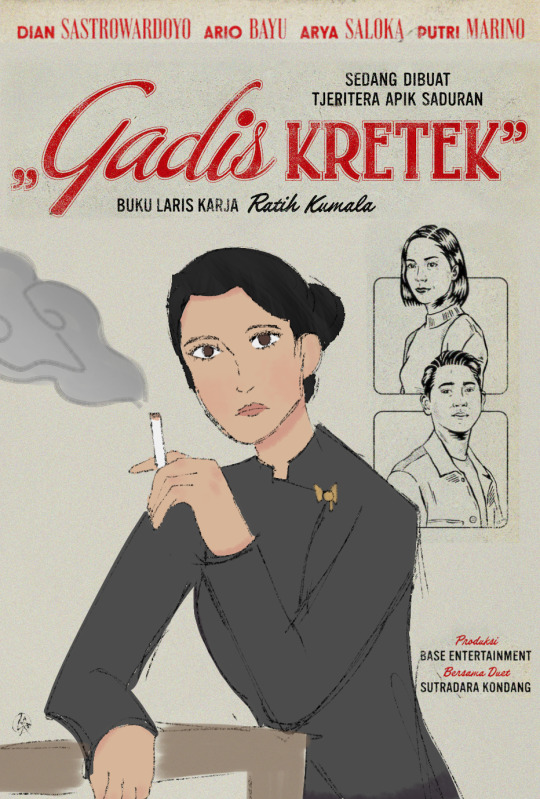
tfw you just want to make good quality cigs but you were born a woman in 1960s javanese culture. also history happens ❤️
(g30spki jumpscare)
#gadis kretek#cigarette girl#netflix#i fuckjng love dian sastro#dian sastrowardoyo#javanese#fanart#art#poster#bahasa indonesia#indonesia#ANJINGGGG CAKEP BGT COY#my art cannot capture how pretty dian sastro is
13 notes
·
View notes
Text
Gang, I might make a YouTube video about Javanese (from the perspective of an American conlanger) because you can't make this shit up.
(Tl;dr: Javanese register is very complicated and very fascinating. Also, what's up with slack-voiced consonants?)
11 notes
·
View notes
Text

Skyward Sword Link wearing baju adat and blangkon
#this is one of my academic art experiments 😭#i love watercolors sm#when i realized i could draw whatever i want i realized i could draw WHATEVER i want#so here ya go link in traditional indonesian clothes#indonesia#skyward sword#skyward link#watercolor#my art#loz#tloz#the legend of zelda#legend of zelda#tloz ss#javanese#baju adat#zelda#zelda skyward sword#link#ss link
19 notes
·
View notes
Text
Arjun’s children.
(+ his kids in the Javanese mhb‼️)
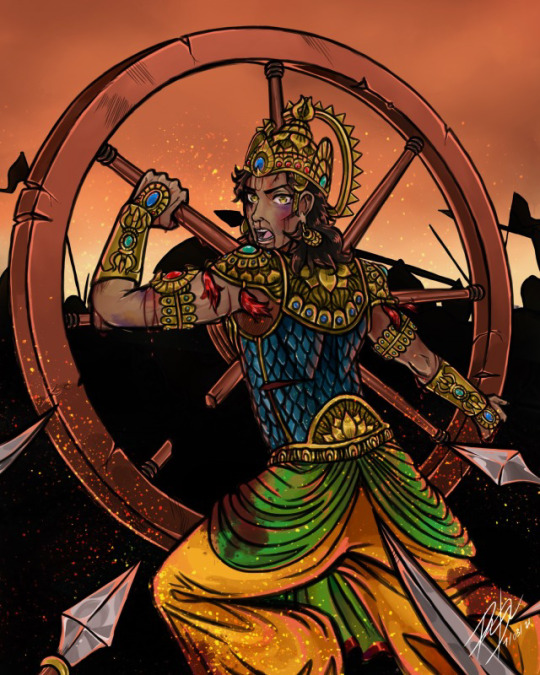
Abhimanyu.
Info: Abhimanyu, the most popular child of Arjun, was a great warrior, portrayed as young, strong and talented. Abhimanyu was one of the people to know the technique to enter the Chakravyuha, a powerful military formation, unfortunately, he died unfairly while in this formation.

Iravan.
Info: Iravan is the second popular son of Arjun, he is the central deity of the cult of Kuttantavar & a village guardian deity. Iravan is revered for his sacrifice & his protection. In one legend, he is married to the enchantress mohini.
(there is much more interpretations/stories of Iravan, so its better to look him up)

Babruvahana.
Info: The harsh son of Arjun & heir of Manipura. Babruvahana was the only child who defeated Arjun, but was about to kill himself after knowing arjun’s identity, but he was given from his stepmother, the Nagi Ulupi, a gem called Nagamani, which revived Arjun.

Shrutakarma.
Info: the youngest of the Upapandavas. Shrutakarma was a capable archer like Arjun and fought very well, he fought many warriors such as Sudakshina, King Chitrasena, Jayatsena, Dushasana and Ashwathama. Unfortunately, he was killed brutally by Ashwathama.

Wisanggeni.
Info: Wisanggeni is a son of Arjun & the lava goddess Dresnala. When he was born, he was already hated by Brahma, in which the creator god threw him into a caldera. However, wisanggeni didn't die but got empowered. In rage by Brahma, he attacked the heavens. No one could defeat him except Antasena (who could only reach him to a draw)

Kumaladewa and Kumalasekti.
Info: Kumaladewa & Kumalasekti are the (male) twin children of Arjun with the demoness Asmarawati. Both siblings are mostly hybrids of a Demi-god and demon, making them possibly powerful. The siblings are seen as hero’s in wayang.

Wilugangga.
Info: born from Arjun & apsara Wilutama, Wilugangga is seen as a hero in Wayang. He helped a king who was facing a hardship, namely a marriage contest, & promised to help him as long as he was told who his father was, the king agreed & after Wilugangga succeeded, he was told who his father was. In the Javanese mhb, he fought Drona but later got killed by him.

Dewi Pregiwa & Dewi Pregiwati.
Info: Pregiwa & Pregiwati are daughters of Arjun & the princess Manuhara and they are only told in wayang.
Pregiwa is said to be loyal, honest, patient, & charming. She had married Ghatotkacha. She is identified with Pragya(?)
Pregiwati is said to be kind, devoted & gentle, and is the twin sister of pregiwa, she once went on a journey to find her father. Pregiwati is identified with Pragati (?)

Sumitra.
Info: son of Arjun and the archer Dewi Larasati, Sumitra is kinda known in wayang. Sumitra is also shown as a charioteer of Abhimanyu, and took part in the Bharatayuda war. he died on the battlefield against Bhishma. (Another version says that he was killed by karna.)
Honorable Mention: Pancala (son of Arjun & Srikandi), but there’s not much info about him I could find.
((Correct me if I got something wrong!!))
#hinduism#hindu mythology#desiblr#mahabharata#arjuna#mahabharat#arjun#Indonesian#java#javanese#Javanese mahabharata#Indonesian mahabharata#abhimanyu#Iravan#aravan#Babruvahana#Shrutakarma#Wisanggeni#Kumaladewa#Kumalasekti#Wilugangga#Pregiwa#Pregiwati#Pragya#Pragati#Sumitra#Pancala#hindublr#desi tag#lotus-list
21 notes
·
View notes
Text
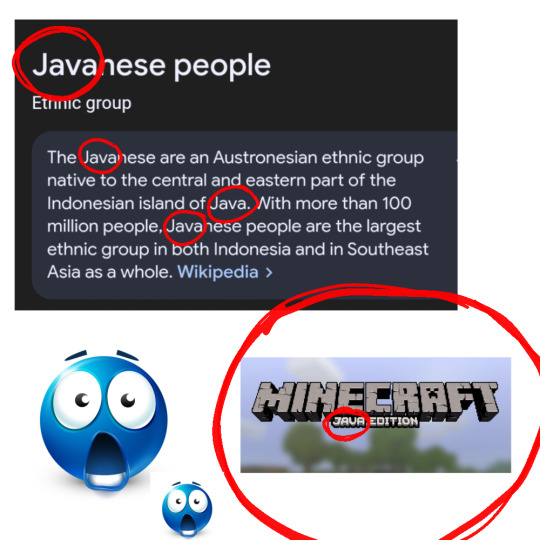
sorry this is so stupid
8 notes
·
View notes
Text

Javanese woman from Suriname
Dutch vintage postcard
#postkaart#ephemera#postal#tarjeta#postcard#postkarte#vintage#carte postale#briefkaart#Suriname#sepia#ansichtskarte#Dutch#Javanese#photo#photography#woman#from#historic
18 notes
·
View notes
Text

The Javanese in Sri Lanka represent a small yet historically and culturally significant ethnic minority group whose roots trace back to the island of Java in modern-day Indonesia. While today their numbers are relatively modest, their legacy reveals a complex tapestry of colonial-era migration, religious and cultural transformation, and assimilation within the broader Moor and Malay communities of Sri Lanka. The Javanese presence in Sri Lanka is deeply interwoven with the dynamics of European colonialism in Southeast Asia and the Indian Ocean world, particularly during the Dutch and British periods. Despite the limited size of the community, their influence has been disproportionately rich in terms of religious practice, cultural retention, and social history.

The migration of Javanese individuals to Sri Lanka began primarily during the period of Dutch colonial rule in the Indian Ocean, particularly in the 17th and 18th centuries. The Dutch East India Company (Vereenigde Oostindische Compagnie, or VOC), which had consolidated control over both Ceylon (modern-day Sri Lanka) and the Dutch East Indies (modern-day Indonesia), often transferred populations across its colonial holdings for administrative, military, and punitive purposes.
A significant portion of the Javanese population in Sri Lanka arrived not as voluntary migrants but as political exiles, slaves, or convicts. Many were members of the Javanese aristocracy or resistance leaders who opposed Dutch rule. These individuals, deemed a threat to colonial control, were exiled from Java to Dutch colonial outposts, including Sri Lanka. One of the most notable cases is that of Prince Susuhunan Pakubuwono II of Surakarta’s entourage and other noble figures who were exiled for their roles in uprisings or suspected subversion. Alongside these elites were soldiers and laborers, including artisans and religious figures, who were brought to Ceylon to serve in various capacities under Dutch command.
This forced migration created a diaspora community that was geographically dislocated but culturally vibrant, maintaining ties to Javanese customs, language, and especially Islam. The migration of Javanese to Sri Lanka also included people from other parts of the Indonesian archipelago, such as Madura and Sumatra, further enriching the ethnic mosaic that would come to be associated with the Sri Lankan Malays, among whom the Javanese would be culturally subsumed over time.

Over the centuries, the Javanese in Sri Lanka were gradually absorbed into the broader "Malay" community—a category that includes peoples from the Malay Archipelago brought to Sri Lanka during the Dutch and British colonial periods. This umbrella term has obscured the distinct ethnic identities of Javanese, Bugis, and other Southeast Asian groups, but it has also provided a collective identity that allowed these migrants and their descendants to maintain a degree of cultural cohesion.
The Malays in Sri Lanka, including those of Javanese descent, primarily settled in the coastal and urban areas of the Western and Southern provinces, including Colombo, Kandy, Hambantota, and Galle. These settlements were often established near colonial administrative centers or military installations where Malays served as soldiers in colonial militias, police, and other service positions.
Javanese linguistic influence in Sri Lanka has largely receded, with Malay and Sinhala being more commonly spoken among descendants. However, vestiges of Javanese vocabulary, particularly in ritual contexts and family heritage, persist in some Malay households. The use of Javanese honorifics, titles, and naming conventions was once common among elite Javanese families in Sri Lanka, especially those descended from nobility.

Religion has played a central role in preserving Javanese identity in Sri Lanka. The majority of Javanese migrants were Muslim, and their Islamic practices aligned with the broader Malay community, which facilitated communal integration. However, the form of Islam practiced by the Javanese often retained elements of Javanese religious culture, including Sufi mysticism and syncretic rituals rooted in pre-Islamic traditions.
Some of the earliest mosques established by the Malays and Javanese in Sri Lanka became centers of religious learning and cultural preservation. These institutions often taught Arabic, Malay, and basic Javanese texts, especially during the 18th and 19th centuries. The Mawlid celebrations, communal prayer sessions, and recitations often featured uniquely Javanese Islamic chants and devotional literature. In particular, Javanese-style Qur'anic recitation and religious poetry—such as syair—were prominent in religious festivities.
Traditional Javanese dress, culinary practices, and ritual customs survived in modified forms. For example, dishes such as "nasi goreng," "sambal," and "satay" made their way into the broader Sri Lankan Malay culinary tradition, although often with localized ingredients. Celebrations such as weddings, coming-of-age ceremonies, and religious festivals still bear traces of Javanese customs, such as batik garments, gamelan-inspired musical rhythms, and traditional Javanese court etiquette.

During the colonial period, Javanese-descended individuals, like other Malays, held positions in the colonial military and police forces. They were considered reliable by the Dutch and later the British due to their perceived loyalty and martial skill. These roles afforded some degree of upward mobility, though they remained socially marginalized compared to the majority Sinhalese and Tamil populations.
In post-independence Sri Lanka, the Javanese community—largely merged into the Malays—has maintained a modest but active presence in political, social, and religious spheres. Malay organizations such as the Sri Lanka Malay Confederation and local mosques have played crucial roles in advocating for minority rights and preserving cultural heritage. While the Javanese identity is often subsumed under the Malay label, some families continue to preserve genealogies and oral histories that trace their roots specifically to Java.
Javanese Sri Lankans have occasionally served as bridges between Sri Lanka and Indonesia, particularly in diplomatic and cultural exchanges. The Indonesian Embassy in Colombo has supported cultural preservation efforts and highlighted the shared heritage between the two countries, sometimes hosting events featuring Javanese dance, music, and cuisine to reconnect diasporic communities with their ancestral culture.

As with many small diaspora communities, assimilation, intermarriage, and modern urbanization have contributed to the erosion of a distinct Javanese identity in Sri Lanka. The younger generation is often more integrated into Sinhala or Tamil linguistic and cultural spheres, and many no longer speak Malay, let alone Javanese. Yet, there is a growing recognition among scholars and cultural activists of the need to document and preserve this unique historical legacy.
Academic interest in the Javanese of Sri Lanka has increased in recent decades, particularly within the fields of Southeast Asian studies, Islamic history, and migration studies. Researchers have focused on archival materials from the VOC, Dutch legal records, family trees, oral traditions, and religious texts to reconstruct the history of Javanese migration and settlement. These studies reveal a community that, while numerically small, made a meaningful contribution to Sri Lanka’s multicultural heritage.
Efforts to preserve the legacy of Javanese Sri Lankans have also included community-based oral history projects, digital archiving of old photographs and documents, and collaborative projects between Sri Lankan Malays and Indonesian cultural organizations. The story of the Javanese in Sri Lanka is increasingly seen not just as a local phenomenon, but as part of a broader narrative of Indian Ocean migrations and the transnational histories of Islam and colonialism.

The Javanese in Sri Lanka represent a microcosm of the broader diasporic experiences shaped by colonialism, forced migration, and cultural resilience. Though many have been absorbed into the larger Malay community, the distinct historical and cultural contributions of Javanese Sri Lankans remain an important part of the island’s diverse social fabric. Their legacy offers insight into the complexities of identity, heritage, and survival in the context of displacement and assimilation. As modern efforts to preserve this heritage grow, the story of the Javanese in Sri Lanka continues to enrich understandings of both Sri Lankan and Southeast Asian history.
#javanese#sri lanka#sri lankan history#javanese diaspora#indian ocean history#colonial history#ethnic studies#cultural heritage#malay sri lanka#islamic history#javanese culture#indonesian diaspora#southeast asia#sri lankan muslims#batik art#javanese traditions#forgotten histories#minority voices#sri lankan malays#diaspora culture#javanese aesthetics#historical migration#ethnography#sri lankan culture#indonesian heritage#java to ceylon#postcolonial studies#muslim communities#oral histories#island histories
2 notes
·
View notes
Text

A Javanese-style glass painting of Dune I made.
#my art#artists on tumblr#painting#glass painting#javanese#dune#dune fanart#paul muad'dib#paul atreides
11 notes
·
View notes
Text
The end of an Era
Yesterday morning, on the 27th of March 2024 my dear cat Neo passed away at an age of almost 17 years. He was the last of our Oriental cats and his passing marks the end of an era for me. Our first Oriental Longhair was Jayto, born November 27th 2003 who later got company of Nintu, a black Oriental Shorthair born August 26th 2006. Sadly, Jayto got sick and died at an age of only 3 years old, not long after Nintu came. Nintu needed another Oriental cat friend because our ‘regular’ cat Joey, who had been with us since early 1995, was not interested in Oriental cat style stickiness. And so Neo came; a black Oriental Longhair born on May 9th 2007. Neo and Nintu have been best buddies for over 13 years. They played together, slept together and went on adventures together- including our family holidays. Their personalities were polar opposites and that made them such a good match.

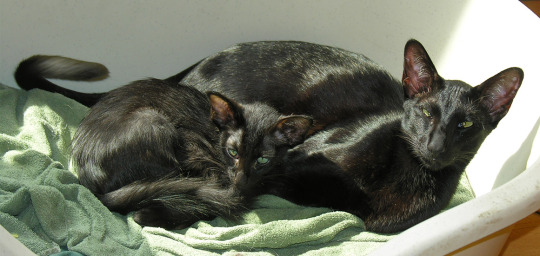
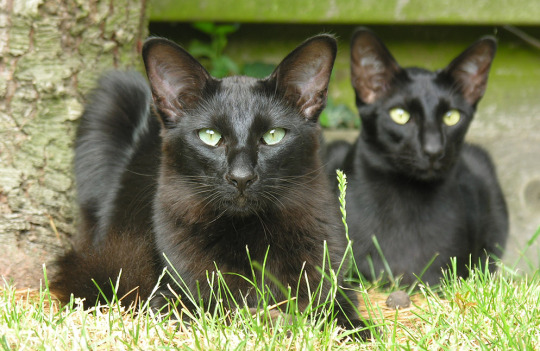
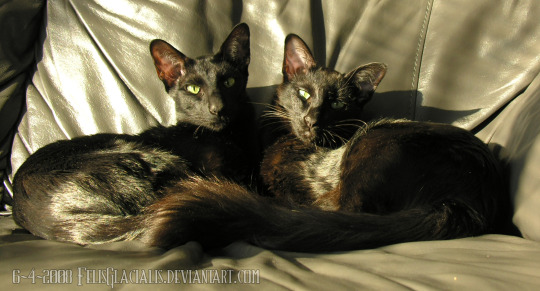
youtube
When Nintu died on May 7th 2020 at an age of almost 14, Neo missed his buddy so much that we adopted Yuka, a red ‘regular’ cat. He gave Neo some proper distraction with his naughtiness - hence his nickname “Geboefte” , which means criminal in Dutch.

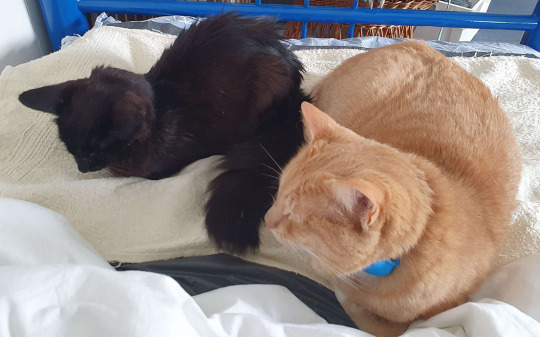

Neo was one of the loveliest, social and most easy going cats whom I’ve known. He was timid and careful but also the most talkative and intimate. Cuddles were almost always welcome and most led to roll and belly-rub session. He had the peculiar habit to do ‘stairs sticky’ as we called it: he stood on the first or 2nd floor while you had to stand a few steps lower on the stairs with your face was at his level and cuddle him.
We often gently joked about his funny look and mannerisms. He was exceptionally small (3.5 kg at max) for a tomcat, always had a bony butt, a pronounced sternum bone that stuck out and a lean but well filled ‘sack of organs’ along with a slightly kinked tail tip. Despite his small size, his paws were proportionally huge, which was not a desired trait for the breed - but I didn’t care; I love big paws. He had a very typical quiet, calm and elegant gait with small steps and an elevated head. Quite the opposite of Nintu’s big steps and -always-in-a-rush- pace. Neo and the other Oriental cats have left us so many precious memories. These will always remain.


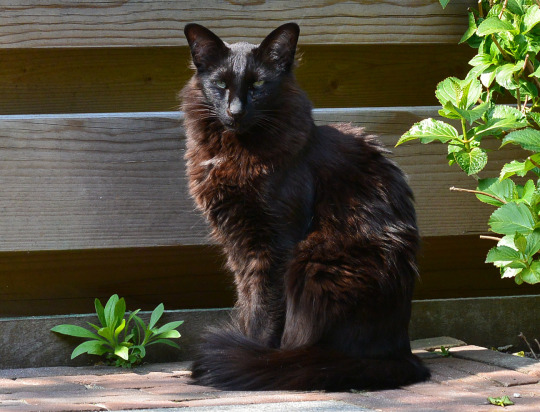

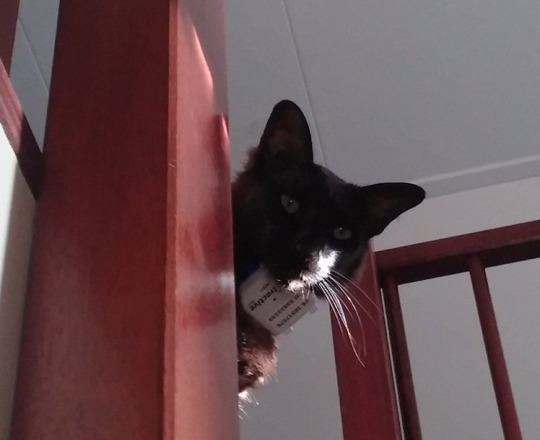
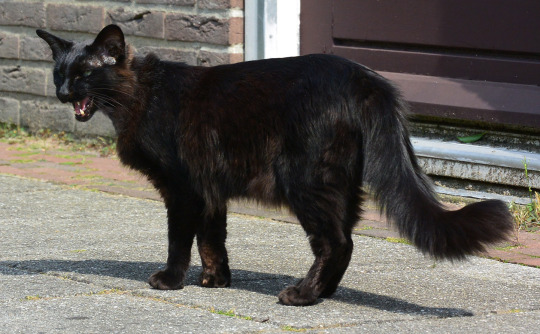
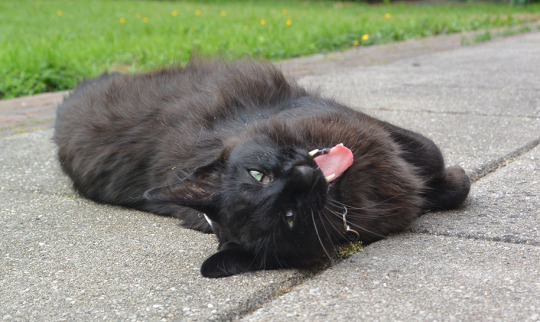
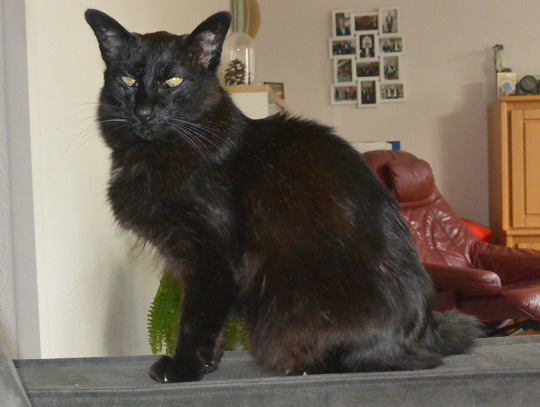
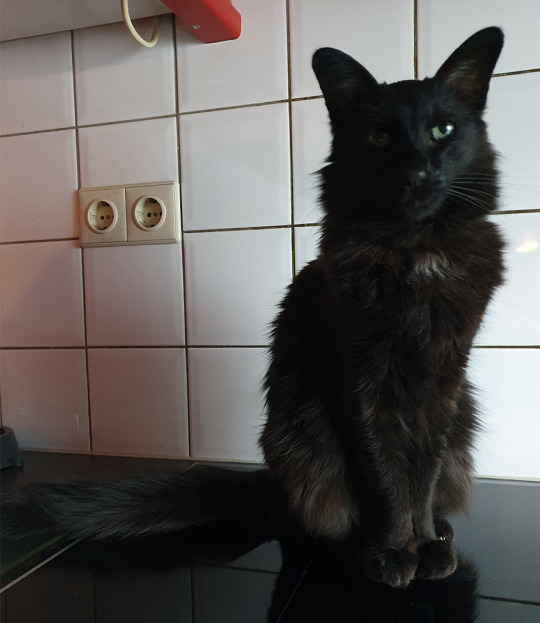

Neo was also the last Feline with whom I had an intimate bond. Since I moved out of my parents’ house in 2012. I was not physically living with him anymore but I came back regularly and Neo was always there to be ‘sticky’ again. Until now. The next time I’m going back, he won’t be there anymore.
But his spirit stays
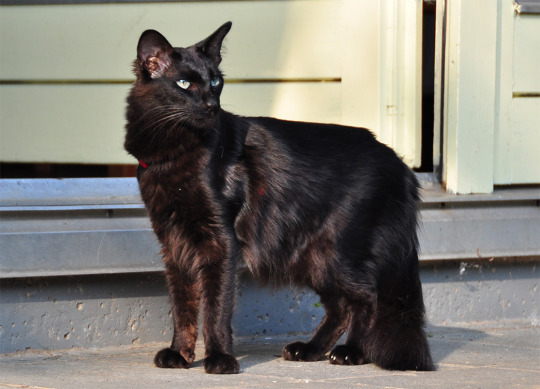
#Neo#end of an era#Oriental Longhair#my Feline friend#Mandarin#Javanese#Oriental cat#Black#Ebony#Youtube
15 notes
·
View notes
Text
Nunca quise tanto volver a vivir ese paseo familiar hasta que un día simplemente ya no se pudo.
17
#javanese#letras#notas#frases#escritos#tristeza#tumblr#desamor#en tu orbita#sentir#cosas de la vida#familia#family#paseo#cosas que nunca te dije#quotes#querer#recuerdos#madrugada
52 notes
·
View notes